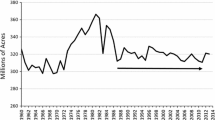Abstract
This paper develops a method for decomposing total factor productivity growth in separable production technologies and uses it to examine the role of pest-damage prevention on agricultural productivity. The rate of technical change is decomposed into output-enhancing and damage-preventing components. Growth accounting cannot provide separate estimates of these two components of technical change, and instead a parametric model is developed based on the dual cost function. The proposed model captures both components of technical change, properly accounts for environmental effects, and also accommodates the presence of capacity utilization and scale biases. The empirical application of the model is to a sample of Cretan olive-oil producers, and the results show that output-enhancing technical change is more important than damage-preventing technical change in explaining observed total factor productivity (TFP) changes. The second largest source of TFP growth is due to the scale effect.
Similar content being viewed by others
Notes
In a slightly different context, this specification can also be interpreted as a stochastic frontier model. In particular if it is assumed that g(x, b, t) measures the extent of technical efficiency then the so called inefficiency-effect model results. By varying the formulation of g(x, b, t), one can distinguish between neutral (Battese and Coelli 1995) and non-neutral (Huang and Liu 1994) stochastic frontier models.
Crete is one of the larger olive-oil producing areas in Greece accounting approximately for 40 % of total national production.
We follow the same approach for the spraying equipment used as a quasi-fixed damage control input.
We did not have the necessary information to estimate a capital services series. By using capital stock instead of capital services we tend to overestimate TFP growth.
It is a standard practice among European olive-growers to monitor adult olive-fruit fly populations using McPhail traps are baited with sex pheromone and ammonium bicarbonate.
Note that this version of the translog form is obtained by specifying a translog cost function for \(c(w,\tilde{y},K,t)\) and then making the substitution \(\tilde{y}=y/g(\bullet)\) where y is observed output.
Accordingly, \(1-g(\cdot)\) is the output damage function originally suggested by Fox and Weersink (1995).
We would like to thank an anonymous reviewer for detecting and pointing out to us an error in our earlier approach to performing this instrumental variables regression.
One interpretation of this procedure is to provide a series approximation using the leading terms in a Taylor series expansion of the conditional moments of independent variables given the instruments used (McFadden and Ai 1997).
Summary statistics for these variables are also given in Table 1.
Our estimates for output enhancing technical change were derived by invoking Ohta’s equality for our estimated cost function, while the rate of preventive technical change was available as a direct by-product of our estimation of the damage-control function \(g(\cdot)\).
References
Amemiyia T (1974) The non-linear two-stages least squares estimator. J Econ 2:105–110
Ball VE, Bureau J-C, Butault J-P, Witzke H (1993) The stock of capital in European community agriculture. Euro Rev Agric Econ 20:437–486
Basu S, Fernald JG, Kimball MS (2006) Are technology improvements contractionary? Am Econ Rev 96:1418–1448
Battese GE, Coelli TJ (1995) A model for technical inefficiency effects in a stochastic frontier production function for panel data. Empir Econ 20:325–332
Bell FW (1972) Technological externalities and common-property resources: an empirical study of the US Lobster industry. J Polit Econ 80:148–158
Beverton JH, Holt SV (1957) On the dynamics of exploited fish populations. Fishery Investigations II, vol 19, London
Bjørn E (2004) Regression systems for unbalanced panel data: a stepwise maximum likelihood procedure. J Econ 122:281–291
Bjørn E, Lindquist KG, Skjerpen T (2003) Random coefficients in unbalanced panels: an application on data from chemical plants. Ann Econ Stat 69:55–83
Breusch TS (1987) Maximum likelihood estimation of random effects models. J Econ 36:383–389
Clark CW (1976) Mathematical bioeconomics. Wiley-Interscience, New York
Diewert WE, Morrison CJ (1986) Adjusting output and productivity indexes for changes in the terms of trade. Econ J 96:659–679
Felthoven RG, Morrison CJ (2004) Directions for productivity measurement in fisheries. Mar Policy 28:161–169
Fox G, Weersink A (1995) Damage control and increasing returns. Am J Agric Econ 77:33–39
Hannessonn R (2007) Growth accounting in a fishery. J Environ Econ Manage 53:364–376
Huang CJ, Liu JT (1994) Estimation of a non-neutral stochastic frontier production function. J Prod Anal 5:171–180
Hulten CR (1986) Productivity change, capacity utilization and the sources of efficiency growth. J Econ 33:31–50
Kalejian H (1971) Two-stage least squares and econometric systems linear in parameters and non-linear in endogenous variables. J Am Stat Assoc 66:373–374
Lichtenberg E, Zilberman D (1986) The econometrics of damage control: why specification matters. Am J Agric Econ 68:261–273
McFadden DL, Ai C (1997) Estimation of some partially specified nonlinear models. J Econ 76:1–37
Morrison CJ (1986) Productivity measurement with non-static expectations and varying capacity utilization: an integrated approach. J Econ 33:51–74
Morrison CJ (1992) Unraveling the productivity growth slowdown in the US, Canada and Japan: the effects of subequilibrium, scale economies and markups. Rev Econ Stat 74:381–393
Oberhofer W, Kmenta J (1974) A general procedure for obtaining maximum likelihood estimates in generalized regression models. Econometrica 42:579–590
Schaefer MB (1957) Some considerations of population dynamics and economics in relation to the management of marine fishes. J Fish Res Board Can 14:669–681
Acknowledgments
This research has received funding from the European Community’s Seventh Framework Programme [FP 7/2008-2011] under Grand Agreement Number 212120. An earlier version of this paper was presented at the XIII EAAE Congress, Zurich, 2011 and in VII NAPW, Houston, 2012.
Author information
Authors and Affiliations
Corresponding author
Rights and permissions
About this article
Cite this article
Chambers, R.G., Karagiannis, G. & Tzouvelekas, V. Productivity accounting for separable technologies. J Prod Anal 41, 41–50 (2014). https://doi.org/10.1007/s11123-013-0367-6
Published:
Issue Date:
DOI: https://doi.org/10.1007/s11123-013-0367-6




